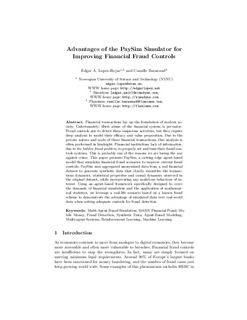Advantages of the PaySim Simulator for Improving Financial Fraud Controls
Journal article, Peer reviewed
Accepted version
Permanent lenke
http://hdl.handle.net/11250/2640900Utgivelsesdato
2019Metadata
Vis full innførselSamlinger
Originalversjon
Advances in Intelligent Systems and Computing. 2019, 998 727-736. 10.1007/978-3-030-22868-2_51Sammendrag
Financial transactions lay up the foundation of modern society. Unfortunately, illicit abuse of the financial system is pervasive. Fraud controls aim to detect these suspicious activities, but they require deep analysis to model their efficacy and value proposition. Due to the private nature and scale of these financial transactions, this analysis is often performed in hindsight. Financial institutions lack of information, due to the hidden fraud problem, to properly set and tune their fraud controls systems. This is probably one of the reasons we are losing the war against crime. This paper presents PaySim, a cutting edge agent-based model that simulates financial fraud scenarios to improve current fraud controls. PaySim uses aggregated anonymized data from a real financial dataset to generate synthetic data that closely resembles the transactions dynamics, statistical properties and causal dynamics observed in the original dataset, while incorporating any malicious behaviour of interest. Using an agent-based framework specifically designed to cover the demands of financial simulation and the application of mathematical statistics, we leverage a real-life scenario based on a known fraud scheme to demonstrate the advantage of simulated data over real-world data when setting adequate controls for fraud detection.
